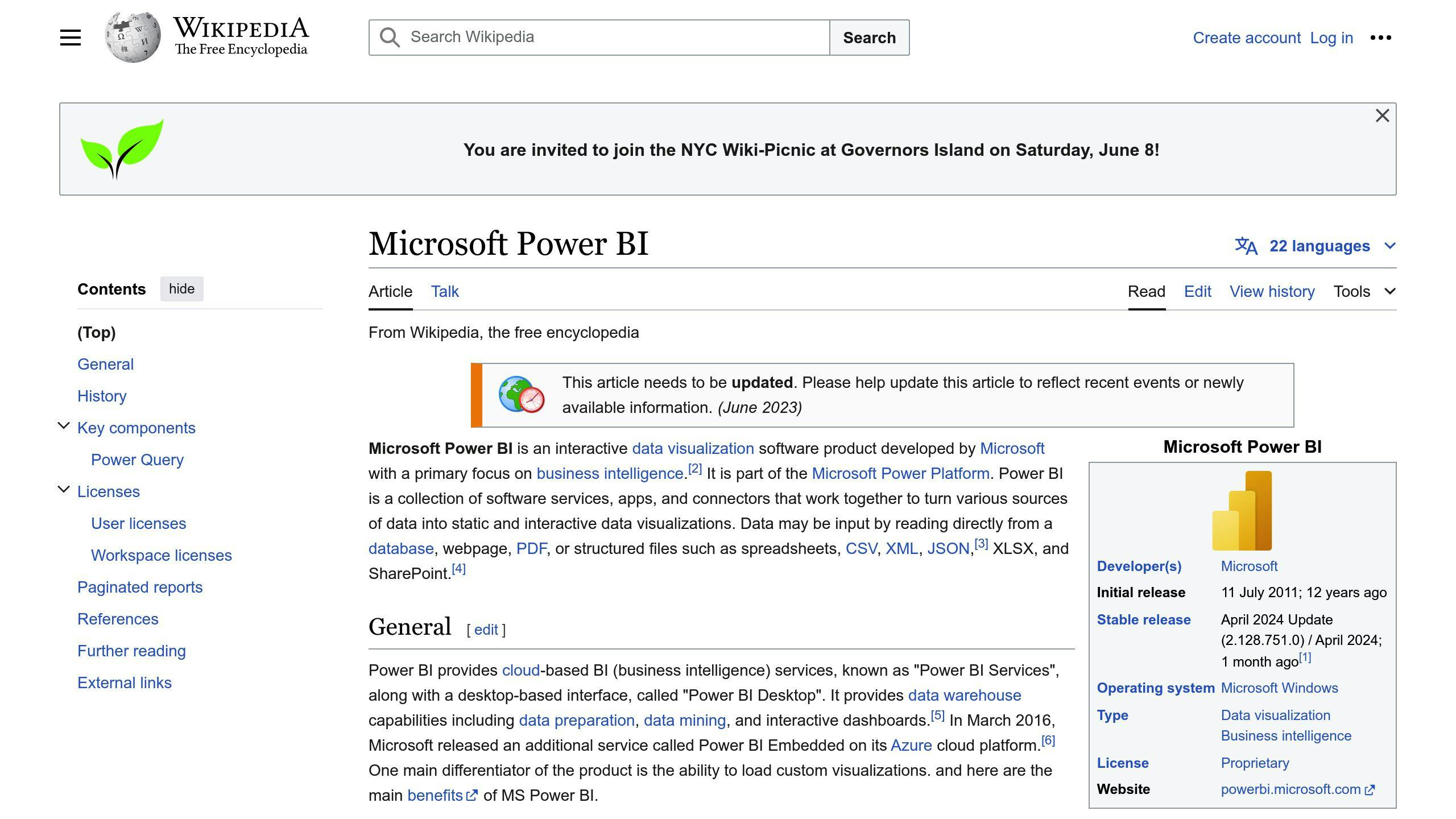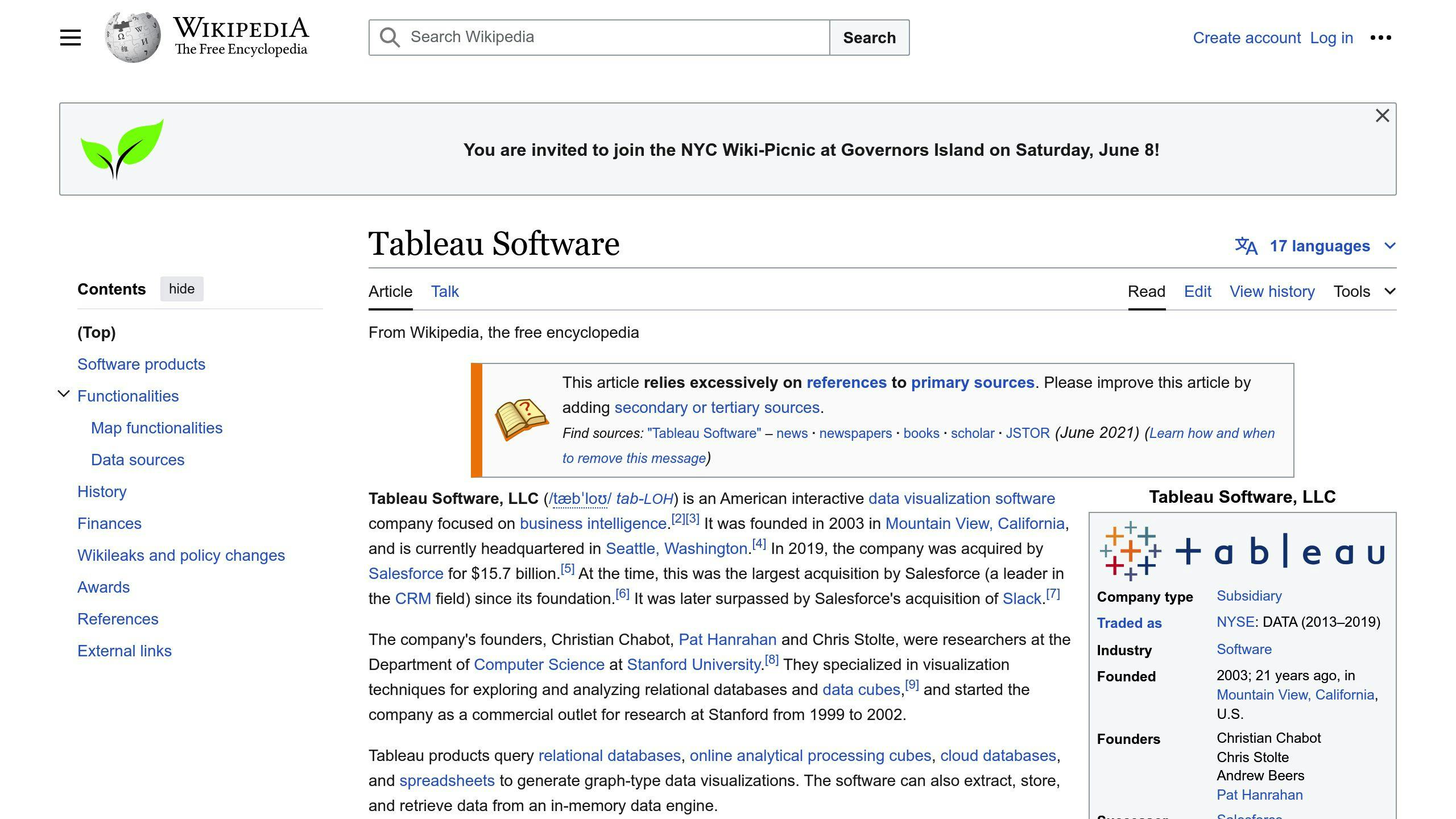Power BI and Tableau are two leading data visualization tools used in finance. Here's a quick comparison:
Pricing
| Tool | Free Version | Paid Subscriptions |
|---|---|---|
| Power BI | Free Desktop version with limited features | Pro: $9.99/user/month Premium: Starts at $4,995/month |
| Tableau | Free trial available | Creator: $70/user/month Explorer: $35/user/month Viewer: $12/user/month |
Key Strengths
| Strength | Power BI | Tableau |
|---|---|---|
| Data Visualization | Standard charts and dashboards | Advanced interactive dashboards and custom visuals |
| Data Handling | Robust data transformation tools | Powerful data blending capabilities |
| Integration | Seamless Microsoft integration | Connects to diverse data sources |
| User Experience | Intuitive, user-friendly interface | More advanced, steeper learning curve |
Recommendations
- For small to medium businesses: Power BI is more affordable and user-friendly, integrating well with Microsoft products.
- For large enterprises: Tableau handles large datasets better and offers more advanced analytics capabilities.
- For cross-platform needs: Tableau is available on Windows and macOS, while Power BI is Windows-only.
- For advanced visualizations: Tableau provides more flexibility and customization options.
Choose the tool that best aligns with your organization's size, budget, existing technology stack, and specific data visualization requirements.
Related video from YouTube
Background Information
Origins and Development
Power BI was launched by Microsoft in 2015 as a tool for business intelligence and data visualization. It evolved from earlier Microsoft products like Excel and SQL Server Reporting Services. Over time, Power BI gained popularity due to its seamless integration with other Microsoft products and user-friendly interface.
Tableau was founded in 2003 and quickly became a leader in data visualization and analytics. It pioneered the use of visual analytics and introduced innovative features like drag-and-drop data exploration. Tableau has continuously enhanced its capabilities, focusing on advanced visualizations and seamless data integration.
Power BI Key Features

Some key features of Power BI for financial data visualization include:
- Microsoft Integration: Power BI seamlessly integrates with other Microsoft products like Excel, SharePoint, and SQL Server, making it a natural choice for organizations using Microsoft's ecosystem.
- User-Friendly Interface: Power BI offers an intuitive interface with drag-and-drop functionality, making it easier for non-technical users to create visualizations and dashboards.
- Data Transformation: Power BI includes robust data transformation and cleaning tools, allowing users to prepare and shape their data for analysis.
Tableau Key Features

Tableau's key features for financial data visualization include:
- Advanced Visualizations: Tableau is known for its advanced visualization capabilities, offering a wide range of chart types and interactive dashboards.
- Data Flexibility: Tableau can connect to various data sources, including databases, spreadsheets, and cloud services, providing flexibility in data integration.
- Data Blending: Tableau allows users to combine and blend data from multiple sources, enabling comprehensive analysis and insights.
Data Visualization in Finance
Data visualization plays a crucial role in the financial sector, enabling organizations to make informed decisions based on data-driven insights. Financial data is often complex, making it challenging to identify patterns and trends through traditional reporting methods. Data visualization tools like Power BI and Tableau help transform raw data into visual representations, allowing users to quickly identify trends, outliers, and correlations.
Effective data visualization in finance can provide several benefits, including:
| Benefit | Description |
|---|---|
| Improved Decision-Making | By presenting financial data clearly and intuitively, data visualization tools enable stakeholders to make better-informed decisions based on insights derived from the data. |
| Enhanced Data Exploration | Interactive visualizations and dashboards allow users to explore financial data from multiple perspectives, uncovering hidden insights and patterns. |
| Effective Communication | Well-designed visualizations can effectively communicate complex financial information to various stakeholders, facilitating better understanding and collaboration. |
| Trend Analysis | Visualizations like line charts and sparklines make it easier to identify and analyze trends in financial data, enabling more accurate forecasting and planning. |
Comparison Criteria
When choosing between Power BI and Tableau for financial data visualization, consider these key factors:
Data Visualization Options
Power BI offers a standard set of visualizations, making it easy to create basic charts and dashboards. Tableau provides a wider range of advanced visualization options, including interactive dashboards and custom visuals.
Handling Financial Data
Power BI excels at transforming and cleaning financial data for analysis. Tableau is better suited for blending data from multiple sources, enabling comprehensive financial analysis.
Data Integration
Power BI seamlessly integrates with Microsoft products like Excel and SQL Server, making it a natural choice for organizations using the Microsoft ecosystem. Tableau can connect to various data sources, including databases, spreadsheets, and cloud services.
User Interface and Ease of Use
Power BI has an intuitive interface with drag-and-drop functionality, making it accessible for non-technical users. Tableau is more powerful but has a steeper learning curve.
Pricing and Licensing
Power BI offers a free version, a Pro plan at $9.99/user/month, and a Premium plan starting at $4,995/month. Tableau's pricing includes a Creator package at $75/user/month and a Server package at $35/user/month.
Performance and Scalability
Both tools handle large financial datasets well, but Tableau can manage larger datasets and more complex calculations, making it better suited for enterprises with massive financial data.
Security and Compliance
Power BI's integration with Microsoft products provides an added layer of security. Tableau offers advanced security features like data encryption and access controls.
Community and Resources
Power BI's community is geared towards Microsoft users, while Tableau's community focuses on data visualization and analytics. Both offer tutorials, webinars, and customer support.
sbb-itb-d1a6c90
Detailed Comparison
Data Visualization Capabilities
Power BI and Tableau offer different strengths in data visualization. Here's a quick overview:
| Feature | Power BI | Tableau |
|---|---|---|
| Standard Visualizations | ✅ | ✅ |
| Advanced Visualizations | ✅ | ✅ |
| Interactive Dashboards | ❌ | ✅ |
| Custom Visuals | ❌ | ✅ |
Power BI provides a range of basic charts and dashboards, making it easy to create standard visualizations. It also offers some advanced options like 3D maps and gauges for financial data analysis.
Tableau, on the other hand, excels in interactive dashboards and custom visuals. It allows users to create complex, dynamic visualizations tailored to their specific needs.
Financial Data Handling
When it comes to working with financial data, Power BI and Tableau have distinct strengths:
| Feature | Power BI | Tableau |
|---|---|---|
| Data Transformation | ✅ | ❌ |
| Data Blending | ❌ | ✅ |
| Financial Data Analysis | ✅ | ✅ |
Power BI shines in data transformation and cleaning, making it a great choice for preparing financial data for analysis.
Tableau, however, is better suited for blending data from multiple sources, enabling comprehensive financial analysis from various perspectives.
Financial Data Integration
Both tools offer robust data integration capabilities, but their approaches differ:
| Feature | Power BI | Tableau |
|---|---|---|
| Microsoft Product Integration | ✅ | ❌ |
| Diverse Data Source Connectivity | ❌ | ✅ |
Power BI seamlessly integrates with other Microsoft products like Excel and SQL Server. This makes it a natural fit for organizations already using the Microsoft ecosystem.
Tableau, on the other hand, can connect to a wide range of data sources, including databases, spreadsheets, and cloud services, providing more flexibility in data integration.
Pros and Cons
Power BI Pros and Cons

Power BI is a business analytics tool from Microsoft. Here are its key pros and cons:
Pros:
| Benefit | Description |
|---|---|
| Cost-effective | Power BI is generally more affordable, especially for small to medium-sized businesses. |
| Microsoft Integration | It integrates seamlessly with other Microsoft tools like Excel, Azure, and SQL Server, making it a natural choice for organizations using the Microsoft ecosystem. |
| User-friendly | Power BI is known for its intuitive interface, making it easy for beginners or non-technical users. |
| BI and Data Warehousing | It excels in data preparation and business intelligence capabilities. |
Cons:
| Limitation | Description |
|---|---|
| Windows Only | Power BI does not natively support macOS, which can be a limitation for some users. |
| Large Datasets | It can experience performance issues with extremely large datasets. |
| Advanced Analytics | It is not as robust as Tableau in handling complex analytical tasks. |
Tableau Pros and Cons

Tableau is a leading data visualization tool. Here are its key pros and cons:
Pros:
| Benefit | Description |
|---|---|
| Advanced Visualizations | It offers greater flexibility and advanced options for data visualization and analytics. |
| Large Datasets | It tends to perform better than Power BI with very large datasets. |
| Cross-platform | It is available on multiple platforms, including Windows and macOS. |
| Community and Support | It has a large, active community and extensive support resources. |
Cons:
| Limitation | Description |
|---|---|
| Cost | Tableau is generally more expensive than Power BI, which might be a concern for individuals or small businesses. |
| Learning Curve | It might be more challenging for beginners or non-technical users to master. |
| Microsoft Integration | While it can connect to various data sources, it doesn't integrate as seamlessly with Microsoft products compared to Power BI. |
Recommendations and Conclusion
When choosing between Power BI and Tableau for financial data visualization, consider the following:
For Small to Medium Businesses
Power BI may be a better choice due to:
- Lower Cost: Power BI is generally more affordable than Tableau.
- Microsoft Integration: It integrates seamlessly with other Microsoft tools like Excel and SQL Server.
- User-Friendly: Power BI has an intuitive interface, making it easier for non-technical users.
For Large Enterprises
Tableau may be a better fit for large enterprises due to:
- Advanced Visualizations: Tableau offers more flexibility and advanced options for data visualization and analytics.
- Large Datasets: It performs better than Power BI with very large datasets.
- Robust Analytics: Tableau is more robust for handling complex analytical tasks.
Cross-Platform Needs
If cross-platform compatibility is important, Tableau is available on multiple platforms, including Windows and macOS.
Advanced Analytics Requirements
If advanced analytics and complex data visualization are crucial, Tableau's robust capabilities make it a better choice.
| Consideration | Power BI | Tableau |
|---|---|---|
| Cost | More affordable | More expensive |
| Microsoft Integration | Seamless integration | Limited integration |
| User-Friendliness | Intuitive interface | Steeper learning curve |
| Advanced Visualizations | Standard options | More advanced options |
| Large Datasets | Can experience performance issues | Handles large datasets well |
| Cross-Platform | Windows only | Available on Windows and macOS |
| Advanced Analytics | Limited capabilities | More robust capabilities |
Both Power BI and Tableau are powerful financial data visualization tools. Choose the tool that best fits your organization's specific needs, size, and requirements. By understanding their capabilities and limitations, you can make an informed decision that meets your financial data visualization needs.
FAQs
Which tool is better for data visualization: Tableau or Power BI?
The choice between Tableau and Power BI depends on your specific needs. Here's a quick comparison:
| Consideration | Power BI | Tableau |
|---|---|---|
| Large Datasets | Can struggle with very large datasets | Handles large datasets well |
| Speed | Faster with smaller datasets | Slower with smaller datasets |
In general, Tableau performs better with significantly large data sets, while Power BI is faster when working with more limited data.
Should I use Power BI or Tableau?
Both tools offer various data storage and connection options. Some are designed for handling large amounts of data, while others ensure real-time dashboard updates. However, Tableau typically outperforms Power BI when dealing with very large data sets. Power BI is quicker when working with smaller data sets. The choice depends on your specific use case and requirements.
What's the main difference between Power BI and Tableau?
The primary difference lies in their strengths:
- Power BI is better at handling large datasets and integrates more tightly with Microsoft products.
- Tableau excels at creating interactive dashboards and provides more advanced customization options.
Choose the tool that aligns best with your organization's needs and existing technology stack.


